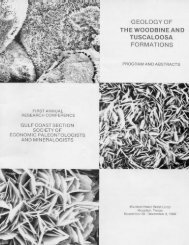Petroleum Systems of Deep-Water Basins - Gulf Coast Section SEPM
Petroleum Systems of Deep-Water Basins - Gulf Coast Section SEPM
Petroleum Systems of Deep-Water Basins - Gulf Coast Section SEPM
You also want an ePaper? Increase the reach of your titles
YUMPU automatically turns print PDFs into web optimized ePapers that Google loves.
<strong>Petroleum</strong> Potential <strong>of</strong> the <strong>Deep</strong>water<br />
Taranaki Basin, New Zealand<br />
Chris Uruski<br />
Institute <strong>of</strong> Geological & Nuclear Sciences<br />
PO Box 30 368<br />
Lower Hutt, New Zealand<br />
e-mail: C.Uruski@gns.cri.nz<br />
Peter Baillie<br />
TGS-Nopec Geophysical Company<br />
Perth, Australia<br />
Abstract<br />
The New Zealand Exclusive Economic Zone (EEZ) contains at least six large deep water basins: the deep water<br />
Taranaki basin, the Raukumara basin, the Pegasus basin, the Head <strong>of</strong> the Bounty trough, the Great South basin and the<br />
Solander trough. Structural styles vary from rift basins through strike-slip dominated basins to major accretionary<br />
prisms. Source rocks encountered include coal measures, black marine shales, and lacustrine facies. Sedimentary<br />
thicknesses, heat flow studies, and basin modeling supported by production and numerous seeps in the shelf and<br />
onshore, suggest that these basins may be prolific hydrocarbon producers in the future. Recent developments suggest<br />
that the most promising <strong>of</strong> these basins is the deep water Taranaki basin, outboard <strong>of</strong> New Zealand’s only producing<br />
basin to date.<br />
The petroleum histories <strong>of</strong> most <strong>of</strong> these basins began with the Late Cretaceous break-up <strong>of</strong> Gondwana and the<br />
formation <strong>of</strong> rift basins. In onshore New Zealand and on the continental shelf, many <strong>of</strong> the source rocks for the productive<br />
Taranaki basin were deposited at this time. The earliest sediments to be deposited were commonly fluvial,<br />
lacustrine, deltaic and nearshore facies followed by an increasing marine influence as the region foundered through<br />
the Paleogene.<br />
The Neogene saw the formation <strong>of</strong> the present plate boundary and the emergence <strong>of</strong> New Zealand in response to<br />
plate collision. Many <strong>of</strong> the more spectacular structures in the New Zealand sedimentary basins were formed during<br />
the Neogene. Meanwhile, the deep water basins away from the plate margin continued a quieter development. Some<br />
inversion occurred, but not to the extent <strong>of</strong> the nearshore and onshore regions. This relatively gentle structural evolution<br />
increased the likelihood <strong>of</strong> discovering large hydrocarbon fields in unbreached structural traps.<br />
16

















